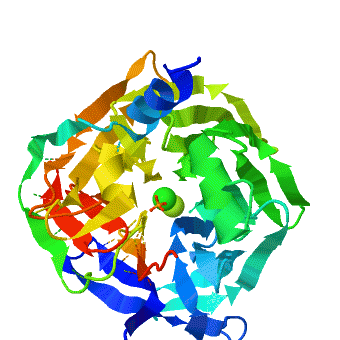Serum Paraoxonase
From Proteopedia
(Difference between revisions)
| Line 4: | Line 4: | ||
'''Serum paraoxonases''' (PONs) or '''aryldialkylphosphatase''' are a group of enzymes that play a key role in organophosphate detoxification and in prevention of atherosclerosis. There are three members in this family, PON1, PON2 and PON3, which share 60-70% nucleic acid identity. The most studied enzymes are the two isoenzymes of PON1, which differ in the residue at position 192 (Q/R). The primary activity of PON1 is lactone hydrolysis; however, this enzyme has many other activities. One of the interesting activities is the hydrolysis of organophosphates. PON1 can catalyze a variety of nerve agents such as cyclosarin, soman, etc. Therefore, it is aimed to be a nerve agent scavenger. In addition, PON1 has a role in prevention of atherosclerosis and is found to be attached to the high-density lipoprotein (HDL, “good cholesterol”). | '''Serum paraoxonases''' (PONs) or '''aryldialkylphosphatase''' are a group of enzymes that play a key role in organophosphate detoxification and in prevention of atherosclerosis. There are three members in this family, PON1, PON2 and PON3, which share 60-70% nucleic acid identity. The most studied enzymes are the two isoenzymes of PON1, which differ in the residue at position 192 (Q/R). The primary activity of PON1 is lactone hydrolysis; however, this enzyme has many other activities. One of the interesting activities is the hydrolysis of organophosphates. PON1 can catalyze a variety of nerve agents such as cyclosarin, soman, etc. Therefore, it is aimed to be a nerve agent scavenger. In addition, PON1 has a role in prevention of atherosclerosis and is found to be attached to the high-density lipoprotein (HDL, “good cholesterol”). | ||
Human PON1 is not stable, and tends to aggregate in the absence of detergents. In addition, it cannot be expressed in bacteria or yeast for protein over-expression, mutagenesis and protein engineering. Therefore, this protein was submitted to directed evolution in order to over-express it in ''E.coli'' and to increase its solubility. Family shuffling of four PON1 genes (human, mouse, rabbit and rat) resulted in many variants that could be expressed in ''E.coli'', but only one of them (G2E6-variant) led to quality-diffracted crystals. The recombinant-PON1 (rePON1) G2E6 variant, exhibits 91% homology to the wt rabbit PON1 and 86% homology to the human PON1. This variant exhibits resemble catalytic activity to human PON1. | Human PON1 is not stable, and tends to aggregate in the absence of detergents. In addition, it cannot be expressed in bacteria or yeast for protein over-expression, mutagenesis and protein engineering. Therefore, this protein was submitted to directed evolution in order to over-express it in ''E.coli'' and to increase its solubility. Family shuffling of four PON1 genes (human, mouse, rabbit and rat) resulted in many variants that could be expressed in ''E.coli'', but only one of them (G2E6-variant) led to quality-diffracted crystals. The recombinant-PON1 (rePON1) G2E6 variant, exhibits 91% homology to the wt rabbit PON1 and 86% homology to the human PON1. This variant exhibits resemble catalytic activity to human PON1. | ||
| + | |||
| + | See also: [[SsoPox: a natural lactose with promiscuous phosphotriesterase activities]]. | ||
==Structural features== | ==Structural features== | ||
Revision as of 10:11, 7 February 2019
| |||||||||||
3D structures of paraoxonase
1v04 – sPON + Ca + phosphate – synthetic
2vc7 – SsPON + thiophenium derivative + Co + Fe – Sulfolobus solfataricus
4kf1 – SsPON (mutant) + Co + Fe + thiophenium derivative
2vc5 – SsPON + Co + Fe
4ke4, 4kes, 4ket, 4keu, 4kev, 4kez, 5vri, 5vrk, 5vsa, 5w3u, 5w3w, 5w3z – SsPON (mutant) + Co + Fe
4hho, 4hhq – sPON + Ca + Br
3sre – sPON + Ca + Br + phosphate
4q1u – sPON (mutant) + Ca + Br + phosphate
3srg – sPON + Ca + Br + oxoquinoline
References
- ↑ Harel M, Aharoni A, Gaidukov L, Brumshtein B, Khersonsky O, Meged R, Dvir H, Ravelli RB, McCarthy A, Toker L, Silman I, Sussman JL, Tawfik DS. Structure and evolution of the serum paraoxonase family of detoxifying and anti-atherosclerotic enzymes. Nat Struct Mol Biol. 2004 May;11(5):412-9. Epub 2004 Apr 18. PMID:15098021 doi:10.1038/nsmb767
- ↑ Gupta RD, Goldsmith M, Ashani Y, Simo Y, Mullokandov G, Bar H, Ben-David M, Leader H, Margalit R, Silman I, Sussman JL, Tawfik DS. Directed evolution of hydrolases for prevention of G-type nerve agent intoxication. Nat Chem Biol. 2011 Feb;7(2):120-5. Epub 2011 Jan 9. PMID:21217689 doi:10.1038/nchembio.510
- ↑ Ben-David M, Wieczorek G, Elias M, Silman I, Sussman JL, Tawfik DS. Catalytic metal ion rearrangements underline promiscuity and evolvability of a metalloenzyme. J Mol Biol. 2013 Mar 25;425(6):1028-38. doi: 10.1016/j.jmb.2013.01.009. Epub 2013, Jan 11. PMID:23318950 doi:10.1016/j.jmb.2013.01.009
- ↑ Ben-David M, Elias M, Filippi JJ, Dunach E, Silman I, Sussman JL, Tawfik DS. Catalytic Versatility and Backups in Enzyme Active Sites: The Case of Serum Paraoxonase 1. J Mol Biol. 2012 Mar 1. PMID:22387469 doi:10.1016/j.jmb.2012.02.042
Proteopedia Page Contributors and Editors (what is this?)
Michal Harel, Alexander Berchansky, Joel L. Sussman, Jaime Prilusky, Eran Hodis, Boris Brumshtein, Moshe Ben-David

